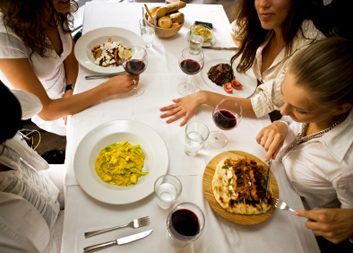
Do your menu homework
If you’re considering a restaurant you’ve never tried before, look up its menu online or stop by to make sure you’ll be able to order the meal you want – many establishments display their menus outside. You won’t be able to learn much about portion sizes, of course, but at least you’ll know whether the menu includes some decent options. You could even pick the safest bets before you go in. That way you won’t have to look at the menu and be tempted by steak smothered in hollandaise sauce or deep-fried cheese blintzes.
If you dine out frequently, keep your own personal list of diet-friendly restaurants in your area – places where you know you’ll be able to get a great-tasting, low-calorie meal.
There are some kinds of restaurants you should avoid altogether…unless you have an iron will. All-you-can-eat joints, buffet-style restaurants and even sprawling salad bars pose a hazard; salad bars can be great for dieters, but many are stocked with calorie-rich dishes like creamy pasta salads. Better to go somewhere where you can get a simple garden salad with dressing on the side. As for fried-chicken and barbecue joints, most of what’s on their menus is so high in calories and fat, you’ll bust your calorie budget before you satisfy your hunger.
Fast-food restaurants have made some progress in offering healthier alternatives to their usual fare, such as grilled chicken sandwiches and salads. But even those can be loaded with hidden calories. Menus change all the time, as chains constantly seek offerings that sell better. And even as they test healthier fare, fast-food restaurants keep adding bigger, unhealthier items as well, or loading up salad with fried chicken and creamy dressing. So while fast-food restaurants offer convenience and familiarity, you’ll need to be extra careful when eating at them. Remember, you’re shooting for at least two servings of vegetables; at your local burger joint, you’ll be lucky to get a piece of lettuce and thin slice of tomato.
Even at pricier restaurants, you need to be specific about your desires or you’ll end up with piles of high-calorie food on your plate. Take control from the start, and don’t let the restaurants dictate your dining experience. Then check out page 190, where you’ll find swaps for some of Canada’s most popular restaurant chains.

Take control of the table
Be the director of your dining experience right from the start, and you really can have it your way. Here are four guidelines that will put you in charge:
Ask and you shall receive. The waitstaff should know how a dish is made, what the ingredients are and how big the portion size is, so don’t be afraid to ask. If the burrito looks good except for the fact that it’s smothered in sour cream, ask them to hold the cream. If you’d like the grilled chicken breast without the skin, say so. If the vegetable side dishes are usually prepared with gobs of butter, request yours lightly sautéed in olive oil or steamed. At pizza joints, ask the kitchen to make yours with no cheese and an extra topping of vegetables.
Order one course at a time. One of the pleasures of dining out is taking your time – or at least it should be. Unfortunately, waiters often snatch up one course and rush in with the next before you’ve had time to put your fork down. Most restaurants want to turn tables around as quickly as they can, so more customers can be served in one evening. But don’t worry: Just relax and take the time you need, within reason.
If you’re worried about being rushed, order just one course at a time. Start with an appetizer. Once you’re done, look back at the menu. Allot at least 20 minutes per course – the time your body needs to send satiety signals. (Better restaurants assume you’ll take a couple hours, anyway.) Feeling full? You’re under no obligation to keep ordering.
Draw the line. Ask whether the kitchen can prepare half portions. Some even offer half portions on the menu. If the dish you order turns out to be too big, ask the waiter to pack up half so you can take it home. Don’t depend on your willpower to eat only half of what’s in front of you. If you already know that the dishes at a particular restaurant are outsized, ask that half be brought to the table and that the other half be brought at the end of your meal in a take-out container.
Rule the table. When you’re dining out, you’re in charge – not only of what you eat, but of what’s on the table. Lots of restaurants start you off with a basket of dinner rolls. If you’re hungry when the rolls arrive, you’ll automatically gobble up mediocre white bread smeared with butter and loaded with calories without even giving it a second thought. Tell the waiter, “No bread, thanks.”
If you’re famished when you sit down, order something more sensible to take the edge off your hunger before you do anything else, such as a side salad, vegetable side dish or glass of spicy tomato juice. At the same time, ask for a glass of water. Heck, ask for a whole pitcher. Then you won’t have to keep the busboy busy filling your glass. Remember to drink plenty of water with your meal.
And don’t forget who’s boss. If something arrives at the table that you don’t want, politely decline.

Manage the menu
Order wisely, and you can put together a meal that’s long on flavour and short on calories. Here are five things to consider when you open the menu:
Be colourful. Meat and cream sauces are usually beige. Choose the most colourful dishes on the menu, and chances are you’ll order the healthiest, lowest-calorie selections – the ones packed with veggies. Spicy red salsas, deep purple beets, green salads, yellow corn, and bright orange and yellow sweet peppers turn your plate into an extra-tasty rainbow. Not only that, but many of the substances that provide fruits and vegetables with their colours are also antioxidants – potent disease-fighters that have been shown to lower heart disease and cancer risk.
Order appetizers and sides. Consider forgoing the entrée section of the menu and ordering only from the appetizers and side dishes. With today’s oversized restaurant portions, an appetizer or side often makes a perfect meal by itself. Skip things like the deep-fried mozzarella sticks, and make sure your choices include at least two servings of vegetables.
Dip into the sauce. Ordering salad dressing on the side is one of the oldest diet tricks. Remember that you can order other sauces on the side, too, from gravy to guacamole. Give yourself no more than a tablespoon.
Here’s another tip: Instead of pouring on the sauce or salad dressing, every time you take a bite, dip the tines of your fork in the dressing, then spear a bite-size portion. You’ll make a little bit of a good thing go a long way.
Create your own smorgasbord. If you’re dining out with friends who share your concern about overdoing it, agree to order and share entrées. If there are four of you, order two or three main dishes. You’ll get a chance to sample a wider variety of items and keep portions down to size.
Be careful, though: When offered a lot to choose from, some people end up eating a lot more. Decide in advance to sample only two or three forkfuls of each dish. With lots of dishes on the table, it’s especially important to be aware of hunger and satiety signals. Sit back from time to time and think about whether you’ve had enough. If you have, put your fork down, raise a glass of water, and enjoy the conversation.
Be a discerning foodie. Remember the credo of smart dining: If it doesn’t taste great, don’t eat it. Sure you paid for it, but to finish something you don’t like is a greater crime.
When you’re dining out this week, be a tough critic. Pay attention to the first few bites. Decide whether it’s good enough to finish, or whether you’d just as soon put those calories toward something else.
120 That’s how many calories there are in a single dinner roll – so tell your server right away that you do not want the bread basket.

One glass will do
Before you raise your glass, remember one key word: moderation. Alcoholic beverages contain calories – about 90 calories in a 120 mL glass of wine and 150 in a 355 mL glass of regular beer (depending on the kind). Surveys show that the average adult who drinks gets 10 percent of total calories from alcohol, so if you must have a glass of wine or beer with dinner, go on and enjoy just one.
It can be easy to get carried away if the people you’re with are ordering tons of food and drinks, but only order what you want. It’s your money and your meal.
Did you know you could change your life in 12 weeks? This simple 12-week step-by-step plan serves up no-nonsense strategies and easy lifestyle changes that tackle one meal, one change… one day at a time. Order your copy of Best Health’s Swap & Drop Diet today!
